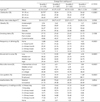Abstract
Purpose
Methods
Results
Figures and Tables
Table 1
General characteristics by categories of energy from eating-out among male adults

1) Data represent mean ± SE. 2) %
Body mass index variable has been age-adjusted.
*p < 0.05 Significance between Quartile 4 and Quartile 3 at α = 0.05 by Tukey-Kramer method
#p < 0.05 Significance between Quartile 4 and Quartile 2 at α = 0.05 by Tukey-Kramer method
†p < 0.05 Significance between Quartile 4 and Quartile 1 at α = 0.05 by Tukey-Kramer method
Table 2
General characteristics by categories of eating-out among female adults

1) Data represent mean ± SE. 2) %
Body mass index variable has been age-adjusted.
*p < 0.05 Significance between Quartile 4 and Quartile 3 at α = 0.05 by Tukey-Kramer method
#p < 0.05 Significance between Quartile 4 and Quartile 2 at α = 0.05 by Tukey-Kramer method
†p < 0.05 Significance between Quartile 4 and Quartile 1 at α = 0.05 by Tukey-Kramer method
Table 3
Energy and nutrient intakes per 1,000 kcal by categories of energy from eating-out among male adults

1) Data represent mean ± SE. 2) Distribution of the subjects 3) Hyper nutrition: energy intake ≥ 125% EER and fat intake > acceptable macronutrient distribution ranges (AMDR) 4) %
All variables have been age-adjusted.
*p < 0.05 Significance between Quartile 4 and Quartile 3 at α = 0.05 by Tukey-Kramer method
#p < 0.05 Significance between Quartile 4 and Quartile 2 at α = 0.05 by Tukey-Kramer method
†p < 0.05 Significance between Quartile 4 and Quartile 1 at α = 0.05 by Tukey-Kramer method
Table 4
Energy and nutrient intakes per 1,000 kcal by categories of energy from eating-out among female adults

1) Data represent mean ± SE. 2) Distribution of the subjects 3) Hyper nutrition: energy intake ≥ 125% EER and fat intake > acceptable macronutrient distribution ranges (AMDR) 4) %
All variables have been age-adjusted.
*p < 0.05 Significance between Quartile 4 and Quartile 3 at α = 0.05 by Tukey-Kramer method
#p < 0.05 Significance between Quartile 4 and Quartile 2 at α = 0.05 by Tukey-Kramer method
†p < 0.05 Significance between Quartile 4 and Quartile 1 at α = 0.05 by Tukey-Kramer method
Table 5
Eating-out food intakes percentage from each food group by categories of energy from eating-out among male adults

1) Data represent mean ± SE.
All variables have been age-adjusted.
*p < 0.05 Significance between Quartile 4 and Quartile 3 at α = 0.05 by Tukey-Kramer method
#p < 0.05 Significance between Quartile 4 and Quartile 2 at α = 0.05 by Tukey-Kramer method
†p < 0.05 Significance between Quartile 4 and Quartile 1 at α = 0.05 by Tukey-Kramer method
Table 6
Eating-out food intakes percentage from each food group by categories of energy from eating-out among female adults

1) Data represent mean ± SE.
All variables have been age-adjusted.
*p < 0.05 Significance between Quartile 4 and Quartile 3 at α = 0.05 by Tukey-Kramer method
#p < 0.05 Significance between Quartile 4 and Quartile 2 at α = 0.05 by Tukey-Kramer method
†p < 0.05 Significance between Quartile 4 and Quartile 1 at α = 0.05 by Tukey-Kramer method
Table 7
Index of Nutritional Quality (INQ) by categories of energy from eating-out among male adults

1) Data represent mean ± SE.
All variables have been age-adjusted.
*p < 0.05 Significance between Quartile 4 and Quartile 3 at α = 0.05 by Tukey-Kramer method
#p < 0.05 Significance between Quartile 4 and Quartile 2 at α = 0.05 by Tukey-Kramer method
†p < 0.05 Significance between Quartile 4 and Quartile 1 at α = 0.05 by Tukey-Kramer method
Table 8
Index of Nutritional Quality (INQ) by categories of energy from eating-out among female adults

1) Data represent mean ± SE.
All variables have been age-adjusted.
*p < 0.05 Significance between Quartile 4 and Quartile 3 at α = 0.05 by Tukey-Kramer method
#p < 0.05 Significance between Quartile 4 and Quartile 2 at α = 0.05 by Tukey-Kramer method
†p < 0.05 Significance between Quartile 4 and Quartile 1 at α = 0.05 by Tukey-Kramer method




 PDF
PDF ePub
ePub Citation
Citation Print
Print


 XML Download
XML Download